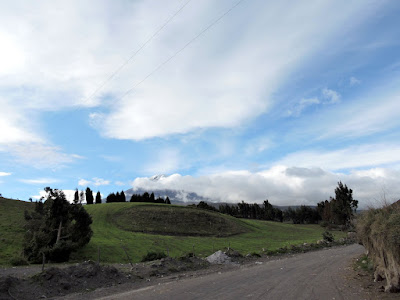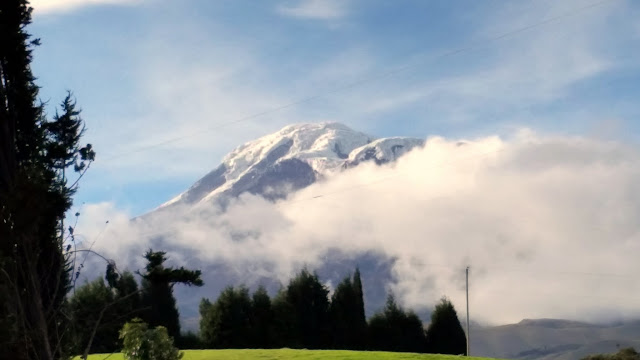As we departed from our astounding experience in Chimborazo, we continued our trek southward to the town of Alausi. It would be in this little town of Alausi where the next day we would board the Devil's Nose Train. Our southward trek to our eventual destination of Cuenca continued to decline in elevation. Our peak for us was at 16,000 feet in Chimborazo. Now as we arrived in Alausi, elevation had dropped to just under 11,000 feet, which was still well above Cuenca's elevation of 8,400 feet, and Quito's 8,600 feet where our trek began.
As we traveled, we came across the oldest church in Ecuador, which was built by the Spaniards in 1534, which was just forty-two years after Columbus' first voyage to the New World.
We arrived in Alausi toward early evening. The most dominate feature of the town is the statue of St. Peter, which most likely is its patron saint, and which hovers over the town from a higher man-made constructed elevation within the city.
Not quite the pearly gates, but close.
The Nativity Scene is at the base of the statue of St. Peter.
Above is a night view of lovely Alausi from the base of the statue of St. Peter.
Alausi by night or day had such a magical quality to me, Marc, and our guide, Milton. If I were a movie producer or a film director, I would not hesitate to use this town for a movie set.
The next morning after breakfast, we walked from our hotel to the train station, and boarded the 11:00 a.m. trip to Silambe. It amazes me when I think of the technological challenge the railroad builders faced 100 years ago. They drilled and carved through the mountains, laid track, and measured inclinations for some very steep drop-offs. Drop-offs, which had to survive downward thrusts bordering on almost vertical declensions without the train leaving the track, and uphill inclinations that required the power of the old steam locomotives to jugged their way onward and upward as they pulled the coaches behind them.

As you can see from the above photo, there is a grandeur to the landscape, however, rocky and vegetation-sparse it may be. Spectacular to see, but for me, not the beauty of the greenery of the mountains and the valleys of Banos-Ambato.

On the train, windows do open. Looking out the window and shooting photos is about as risky as things get. Up until the 1990's, people could ride on the roof of the train cars. Imagine the thrill of those rides. Needless, to say, people died, and the government eventually removed one more risk to lost lives.
Already, in the photo above, you can see our approach of the Silambe train station.

Tickets are for reserved seating, but don't fret. Once the ride begins, passengers are constantly moving about. You will be able to get photos from every possible vantage point. I must admit, however, that our car was probably half-full that day, so I can't say if maneuverability is as easy on a day when the coaches are filled to near capacity.
As we disembarked, my son wasted no time making friends.
The next forty-five minutes to an hour was spent at the Silambe stop, before returning to Alusai. Silambe is a modern facility focused on tourists, with refreshments, a restaurant, and shops.
We had refreshments in the roof-top restaurant, after a long stair-way climb up the side of the mountain to the restaurant, and of course, to further shops.
Below is an aerial view of the Silambe station from the restaurant.
As we arrived, there were indigenous dancers performing traditional dances that are still a part of their culture today.
I paid little attention to the dancers on our arrival, but after a respite in the restaurant, we made our way down to watch the dancers perform as we waited for the return ride.
The dancers then encouraged the passengers to join them. The lady with whom I was dancing in the photo below, kept me dancing for ten minutes, until it was time to board the train again. I very much enjoyed this part of the day.
Upon our return to Alausi, we ate lunch at a local restaurant before we traveled to Ingapirca.
Equatorianos are great soup-makers. Some folks like croutons or crackers sprinkled on their soup, Equatorianos prefer pop corn.
Tickets can be purchased on-line, after filling out a lengthy form of personal information. Tickets can also be arranged, along with accommodations if necessary, through travel agencies in cities like Cuenca. If the trains are not filled, tickets can also be purchased on site at the station in Alausi. However, if your are an international tourist or an expat, you must provide your passport number to purchase a ticket. On-site at the station requires that you show your passport. If your ticket was purchased on-line, you also need your passport when boarding the train. Dependent upon the personnel with whom you come into contact at the station, you may or may not be required to show your passport, so cover all bases by being sure that you have your passport with you.
It was early afternoon, and now the three of us still had plenty of time to continue our southward trek, next to Ingapirca--the largest known Inca ruin in Ecuador.



















































